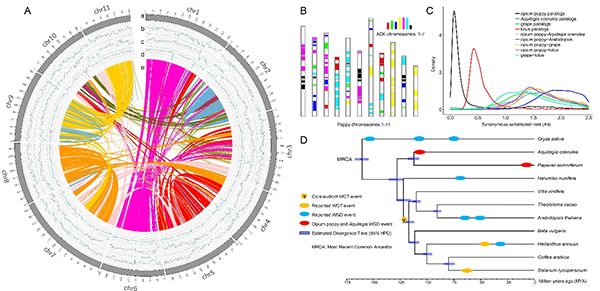
Opium poppy genome characteristics and major evolutionary events
On August 31st, an international team co-led by professor Kai Ye at Xi'an Jiaotong University, together with British Royal Society Fellow Ian Graham of York University, and Dr. Ning Zemin from the Wellcome Trust Sanger Institute, published a research paper entitled "The opium poppy genome and morphinan production” on Science. The is the first high-quality whole genome sequence of opium poppy in the world, revealing major genome duplications and rearrangement events in its evolutionary history. It reported an ultra-long biosynthetic gene cluster for the production of benzylisoquinoline alkaloids. This work has laid an important foundation for further utilization of the medicinal value from opium poppy and revealed the evolutionary history of the Papaveraceace family and even the early eudicots. Among the author list, the associate professor Li Guo and assistant professor Xiaofei Yang are the joint-first authors of this article. Professor Ye Kai is the Co-corresponding author. This study was supported by National Natural Science Foundation of China.
The flowers of opium poppy are often referred as "flowers of evil", because although their flowers are attractive, their fruits, the source of opium, also induce addiction. On the other hand, it is a wonderful medicine as pain-killer. Traces of opium poppy usages were found in the caves at the foot of the Alps in the Neolithic Age. During the Tang Dynasty, they were introduced to China through the Silk Road. "Materia Medica" has described the pain-relief effect of opium poppy. In fact, the morphine alkaloids extracted from opium poppy are powerful analgesics and the narcotic ingredients also have significant antitussive and anti-cancer effects. Unfortunately, there is currently a lack of systematic and comprehensive understanding of the medicinal value of opium poppy impeding exploiting its greater value.
The whole genome assembly of the opium poppy genome is challenging. Since the opium poppy genome has a high percentage of repetitive sequences and has undergone many large-scale structural variations, it is extremely difficult to decode the genome.
Professor Ye’s team utilized various state-of-art genome sequencing techniques, sophisticated mathematical models, comprehensive data mining and analysis methods, allowing them to successfully decipher the opium poppy genome and reveal its evolutionary history.
This study has shown that the opium poppy genome had a whole genome-wide duplication event at 7.8 million years ago, and segmental duplication events occurring at least 110 million years ago. In addition, this is the first time that 15 genes are found forming a super gene cluster on chromosome 11, responsible for the biosynthesis of cough-suppressing and anticancer noscapine as well as analgesic morphine alkaloids. Interestingly, the gene cluster is specifically expressed and co-expressed in tap roots and stems where the synthesis of these alkaloids is known to occur.
Co-corresponding author Professor Kai Ye from Xi’an Jiaotong University said: “Highly repetitive plant genome and the intermingled evolutionary events in the past 100 million years complicate our analysis. We utilized complementary cutting-edge genome sequencing technologies with sophisticated mathematic models and analysis methods to investigate the evolutionary history of opium poppy genome. It is intriguing that two biosynthetic pathways came to the same genomic region due to a series of duplication, shuffling and fusion structural events, enabling concerted production of novel metabolic compounds.”
Co-corresponding author, Professor Ian Graham, from the Centre for Novel Agricultural Products, Department of Biology at the University of York, said: “Biochemists have been curious for decades about how plants have evolved to become one of the richest sources of chemical diversity on earth. Using high quality genome assembly, our study has deciphered how this has happened in opium poppy. At the same time this research will provide the foundation for the development of molecular plant breeding tools that can be used to ensure there is a reliable and cheap supply of the most effective painkillers available for pain relief and palliative care for societies in not just developed but also developing world countries”.

Add: 83 Shuangqing Rd., Haidian District, Beijing, China
Postcode: 100085
Tel: 86-10-62327001
Fax: 86-10-62327004
E-mail: bic@donnasnhdiary.org
京ICP备05002826号 文保网安备1101080035号 Copyright 2017 NSFC, All Right Reserved